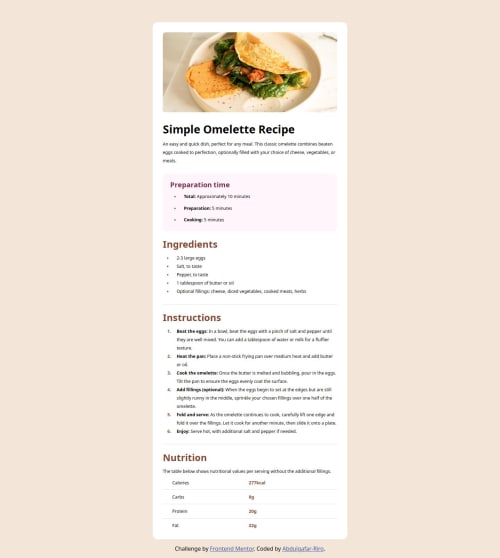Responsive Recipe Page with Semantic HTML and Custom CSS Variables

Solution retrospective
What I am most proud of:
Successfully creating a fully responsive recipe page that maintains a clean, professional layout across various screen sizes.
Implementing semantic HTML to ensure the page is accessible and follows best practices.
Utilizing CSS variables to streamline theme management and improve maintainability.
Incorporating custom fonts for a visually appealing and unique design.
What I would do differently next time:
Optimize the project further by compressing image files for faster load times.
Include ARIA roles and additional accessibility features to enhance usability for screen readers.
Add animations or transitions to improve the user experience and make the interface more interactive.
Explore using a preprocessor like SASS for better CSS organization in larger projects.
Test the design across more devices and browsers to ensure consistent performance.
What challenges did you encounter, and how did you overcome them?Challenges Encountered:
- Ensuring Responsiveness Across Devices:
Designing a layout that adapts seamlessly to different screen sizes was challenging, particularly for smaller devices.
Solution: I utilized CSS Flexbox and media queries to create a responsive design and tested it across various screen resolutions.
- Font Integration Issues:
Embedding and loading custom fonts correctly caused minor formatting inconsistencies.
Solution: I ensured proper file paths and formats for the fonts and verified compatibility across browsers.
- Maintaining Accessibility:
Ensuring the design was accessible to all users, including those relying on screen readers, required additional effort.
Solution: I used semantic HTML, descriptive alt attributes for images, and consistent heading structures to improve accessibility.
- Styling Complex Elements:
Designing the nutrition table to look clean and readable without breaking the layout was tricky.
Solution: I applied a minimalistic design using CSS variables and adjusted padding and borders for clarity.
- Managing Consistent Styling:
Keeping the styles consistent across different sections and ensuring scalability posed a challenge.
Solution: I implemented CSS variables for colors, spacing, and typography to maintain uniformity.
Through persistence, testing, and iterating on the design, I was able to address these challenges effectively.
What specific areas of your project would you like help with?Areas I Would Like Help With:
- Accessibility Improvements:
Suggestions for further enhancing accessibility, particularly for users relying on assistive technologies.
- Responsive Design Optimization:
Feedback on ensuring a flawless layout on larger screens and more complex resolutions.
- Code Optimization:
Recommendations for making the code more concise, reusable, and scalable.
- Typography and Styling:
Advice on improving the visual hierarchy and overall aesthetic appeal of the project.
- Performance Optimization:
Techniques to improve load times, especially for assets like custom fonts and images.
Your insights would help refine the project further and ensure it meets best practices.
Please log in to post a comment
Log in with GitHubCommunity feedback
No feedback yet. Be the first to give feedback on Abdulgafar-Riro's solution.
Join our Discord community
Join thousands of Frontend Mentor community members taking the challenges, sharing resources, helping each other, and chatting about all things front-end!
Join our Discord